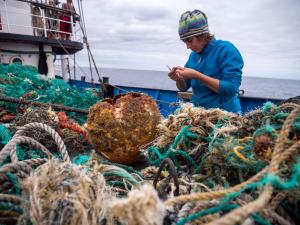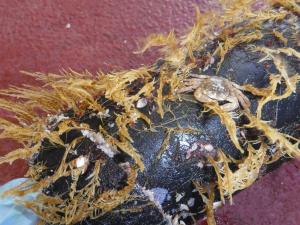
Anika Albrecht of Ocean Voyages Institute collecting plastic. Credit: Ocean Voyages Institute.

Debris with coastal and open-ocean organisms. Credit: The Ocean Cleanup /Smithsonian Institution
Ocean plastic is creating new communities of life on the high seas
From University of Hawaiʻi at Mānoa, Jan 6, 2022
Coastal plants and animals have found a new way to survive in the open ocean—by colonizing plastic pollution. A commentary published in Nature Communications reported coastal species growing on trash hundreds of miles out to sea in the North Pacific Subtropical Gyre, more commonly known as the “Great Pacific Garbage Patch.”
The authors, including two oceanographers from the University of Hawaiʻi at Mānoa School of Ocean and Earth Science and Technology (SOEST), call these communities neopelagic. “Neo'' means new, and “pelagic” refers to the open ocean, as opposed to the coast.
For marine scientists, the very existence of this “new open ocean” community is a paradigm shift. Plastic is providing new habitat in the open ocean. And somehow, coastal rafters are finding food.
Now, scientists have to wrestle with how these coastal rafters could shake up the environment. The open ocean has plenty of its own native species, which also colonize floating debris. The arrival of new coastal neighbors could disrupt ocean ecosystems that have remained undisturbed for millennia. Vast colonies of coastal species floating in the open ocean for years at a time could act as a new reservoir, giving coastal rafters more opportunities to invade new coastlines.
Clues of 2011 tsunami
Scientists first began suspecting coastal species could use plastic to survive in the open ocean for long periods after the 2011 tsunami in Japan, when they discovered that nearly 300 species had rafted all the way across the Pacific on tsunami debris over the course of several years. But until now, confirmed sightings of coastal species on plastic directly in the open ocean were rare, and the ability of coastal species to reproduce in the pelagic ocean was not proven.
Gyres of ocean plastic form when surface currents drive plastic pollution from the coasts into regions where rotating currents trap the floating objects—including microplastics, nets, buoys and bottles—carrying organisms from their coastal homes with them.
SOEST scientists Nikolai Maximenko and Jan Hafner created models that could predict where plastic was most likely to pile up in the North Pacific Subtropical Gyre and shared that information with Ocean Voyages Institute, a nonprofit that collects plastic pollution on sailing expeditions. Together with other members of the team, they also designed, built and deployed a suite of Lagrangian instruments to observe physical and biological processes governing the floating ecosystem.
A new open ocean
During the first year of the COVID-19 pandemic, Ocean Voyages Institute founder Mary Crowley and her team managed to collect a record-breaking 103 tons of plastics and other debris from the North Pacific Subtropical Gyre. She shipped some of those samples to the Smithsonian Environmental Research Center (SERC) Marine Invasions Lab. There, lead author Linsey Haram analyzed the species that had colonized them. She found many coastal species—including anemones, hydroids and shrimp-like amphipods—not only surviving, but thriving, on marine plastic.
“The issues of plastic go beyond just ingestion and entanglement,” said Haram. “It’s creating opportunities for coastal species’ biogeography to greatly expand beyond what we previously thought was possible.”
As the world’s dependence on plastic continues to climb and with fiercer and more frequent storms on the horizon as a result of climate change, the authors expect even more of that plastic will get pushed out to sea. This long-overlooked side effect of plastic pollution, the authors said, could soon transform life on shore and in the sea.
The latest discovery is one of the main results of the FloatEco project, funded by NASA’s “Life in the Moving Ocean” initiative and led by Maximenko and Hafner teaming up with lead author of the publication and former postdoctoral fellow Haram; Greg Ruiz, head of the SERC Laboratory of Marine Invasions; Ocean Voyages Institute; and scientists from the Lagrangian Drifter Laboratory at Scripps Institution of Oceanography, Applied Physics Laboratory at University of Washington, Williams College, and Ocean and Fisheries Canada.